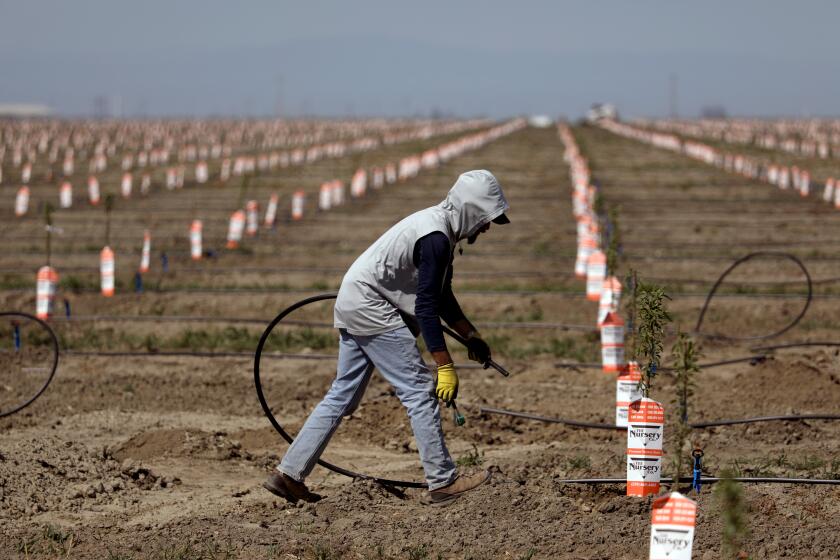Newsom promises while the delta dies

- Share via
The West Coast’s most important estuary is dying, and Gov. Gavin Newsom has hastened its demise.
As he took office two years ago, Newsom promised to generate voluntary agreements among farmers, environmentalists and government officials on the rules for allocating water that flows through the Sacramento-San Joaquin Delta. One year ago, in a CalMatters op-ed, he said again that agreements were the way forward to “protect, restore, and enhance … the Delta.”
Not only have no voluntary agreements emerged, but conditions in the delta have grown so dire that in March the National Marine Fisheries Service estimated that high water temperatures could kill 90% of endangered winter-run Chinook salmon in the Sacramento River this year.
The delta is California’s hydrological hub. Its sprawling watershed covers 40% of the state, and two-thirds of California’s 40 million residents drink water that flows through it. It generates California’s largest fishery, producing most of the state’s salmon, and it is also a National Heritage Area, a unique combination of multicultural communities whose 500,000 inhabitants include many descendants of 19th century Asian and Mexican laborers.
This enormous nexus of interests — from Eureka salmon fishers to San Diego residential water consumers — merges in a region on life support, increasingly vulnerable to saltwater intrusion, toxic algal blooms, rising sea level, land subsidence, drought and water diversions.
Yet Newsom is showing more concern for a relatively small group of prosperous Central Valley farmers than he is for the tottering delta’s human and animal constituents.
Soon after taking office, Newsom declined to reappoint then-Chair Felicia Marcus to the State Water Resources Control Board. Marcus was responsible for a carefully considered, science-based plan to update outmoded 1995 delta water allocation regulations. Her removal from the board effectively sidelined that plan, and with it minimum delta flows that salmon and other species need for a reasonable chance of survival.
The first of the plan’s two phases — approved but not yet implemented — called for leaving unimpaired 30% to 50% of flows in the lower San Joaquin River Basin at critical times of the year; water districts there had sometimes diverted as much as 90% of flows for municipal users and (mostly) agribusiness.
District officials and Central Valley farmers howled. Newsom, arguing that Marcus’ plan would inevitably be snarled in litigation, advocated voluntary agreements instead. True enough, Marcus’ plan has attracted numerous lawsuits, but voluntary agreements would be just as susceptible to litigation, and in any case, state officials have been trying to negotiate voluntary compromises on the flows for at least a decade with no success.
Meanwhile, the delta ecosystem continues to collapse. So few salmon have returned to the Sacramento River, where most of the state’s salmon spawn, that this year the commercial salmon season probably will be cut in half, and the prospects for salmon survival are hurtling downward. A mere 75 years ago, millions of smelt inhabited the estuary; now, so few have been sighted that scientists worry they may go extinct this year. So much water has been diverted from the delta that in places its flow has turned sluggish or stagnant. That, combined with nutrients in agricultural runoff that collect in the estuary, has provided perfect breeding conditions for algal blooms toxic enough to kill animals and sicken humans. The blooms are an annual phenomenon.
A charitable interpretation of Newsom’s water board moves is that he committed a rookie mistake: He didn’t realize that when he undercut Marcus’ plan, he also dissolved the water users’ motivation to negotiate voluntary agreements. Newsom put forward a compromise plan, but since then, negotiations for voluntary agreements have broken down. The delay benefits farmers because diversions allowed by the 1995 regulations — universally regarded as inadequate to protect or restore the delta — remain in effect.
As the state descends into its latest drought, and with the risk of future droughts intensifying along with climate change, the delta’s situation will only worsen. Water users, especially Central Valley farmers who have been shifting from row crops to more lucrative permanent crops such as almonds, pistachios and walnuts, will continue to pressure politicians for water. Though farmers can cut back on water for row crops by letting fields lie fallow during droughts, permanent crops require water every year, drought or no drought.
As the San Joaquin Valley braces for yet another season of drought, some growers are openly questioning the future of farming here.
Newsom’s aides told the Sacramento Bee in February that compromise was still in the offing, but given the drought and the recall effort targeting the governor, it’s highly unlikely that he’ll risk provoking farmers and municipal users this year by limiting their water allocations. It may not be a coincidence that Stewart and Linda Resnick, billionaire owners of Wonderful Co., which grows pistachios on more than 100,000 acres in the San Joaquin Valley, donated $250,000 in March to Newsom’s anti-recall campaign.
That kind of support gives rise to a more cynical interpretation of the governor’s squelching of the Marcus-led plan: Far from making a rookie mistake, he knew exactly what he was doing.
Jacques Leslie is a contributing writer to Opinion.
More to Read
A cure for the common opinion
Get thought-provoking perspectives with our weekly newsletter.
You may occasionally receive promotional content from the Los Angeles Times.










